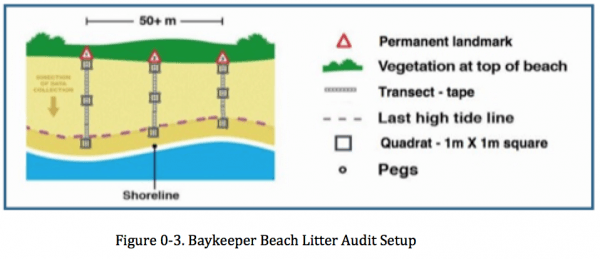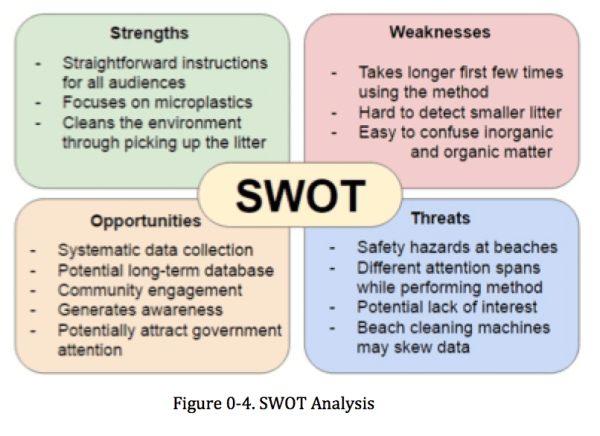Authors
Cierra K. Ford, Andrea C. Bayas, Maura J. Buckley, Javier A. Lawes
Sponsor
Port Phillip EcoCentre
Advisors
Stephen M. McCauley, William R. Michalson
Term
March – May 2017
Abstract
This project was intended to help the Port Phillip EcoCentre establish a long-term monitoring program to track microplastic pollution in Port Phillip Bay. We trialled, assessed, and designed an implementation plan for the Baykeeper Beach Litter Audit at nine pre-selected sites. We collected preliminary data and developed informational guides, instructional videos, and promotional flyers to recruit and inform citizen scientists. The monitoring program has potential to serve as a tool for management of the bay over the next fifty years.
Executive Summary
Project Overview
Eight million tons of plastic enter the marine environment each year, and an estimated 5.25 trillion pieces of plastic have accumulated in the ocean. Plastic consumption continues to increase, and the amount entering the marine environment is an issue because the synthetic polymers that plastics are composed of do not fully degrade. This means that once a plastic enters the environment, its plastic components will perpetually harm the environment. However, plastic debris will not always remain in the form of a plastic bag or water bottle. Once plastic litter makes it to the ocean, it degrades into smaller pieces due to weathering, ultraviolet radiation, and the properties of seawater. Eventually, plastics break down into microplastics, defined as pieces with diameters less than 5 millimeters. Apart from being formed by the breakdown of larger plastics, microplastics also include plastic resin pellets, or nurdles, which are used in plastic manufacturing, microbeads, components of several hygiene products, and microfibers, the synthetic particles that come off of clothing in washing machines. Regardless of their source, microplastics present harm to the marine environment because they contain pollutants and can be easily mistaken for food by marine wildlife due to their small size. When fish ingest microplastics, they absorb their pollutants, and through a process called biomagnification, these pollutants can move up the food chain, putting other animals as well as humans at risk.
Microplastic pollution is an emerging global concern; therefore, there is a lack of knowledge and awareness surrounding the topic. Nevertheless, some communities, including the Port Phillip Bay area, have taken initial steps to address microplastic pollution. Port Phillip Bay is located in the southern part of the Australian state of Victoria. The bay is surrounded by four main catchments and multiple sub-catchments, which are home to two-thirds of Victoria’s total population. There are several rivers and creeks that run through these catchments and discharge into the bay. These waterways play an important role in providing the Port Phillip Bay area with aesthetic appeal, recreational opportunities, tourism, ecosystem foundations, and wildlife habitat. However, these rivers and creeks also serve as a path for litter to travel from the catchments into the bay. The litter that enters Port Phillip Bay circulates the bay with the clockwise current for an estimated 1.65 years before it is released into the open ocean through Bass Strait.
Neil Blake, the Port Phillip Baykeeper, as part of Waterkeeper Alliance, strives to keep the bay clean by taking action, educating the community, and promoting the cause through a variety of projects. Neil developed the Baykeeper Beach Litter Audit to address microplastic pollution in Port Phillip Bay. It is a systematic method for collecting and recording litter at beaches around the bay. It focuses on microplastics unlike other methods to collect and sample debris from the marine environment. Due to the complexity of the microplastic pollution issue, citizen science is an appropriate approach to get more people involved. Citizen science projects depend on community participation for data collection, and the data is sent to scientists and other experts for analysis.
Project Objectives
The goal was to use the Baykeeper auditing methodology to establish a long-term monitoring program to track microplastic pollution in Port Phillip Bay. This program will be maintained by citizen scientists and will provide a tool for management in the bay for the next 50 years. Our project team, in collaboration with the Port Phillip EcoCentre, developed the following objectives to achieve this goal.
- Understand the Port Phillip EcoCentre’s values and goals.
- Understand the different perspectives on microplastic pollution in Port Phillip Bay.
- Trial and assess the Baykeeper Beach Litter Audit and determine implementation protocols at each pre-selected site around the bay.
- Analyze preliminary data on the distribution of microplastics around the bay.
- Prepare outreach and instructional materials to ensure consistent implementation by citizen scientists.
Sponsor and Stakeholder Perspectives
It was important to understand the Port Phillip EcoCentre to accustom ourselves with the organization’s values. We participated in some of their programs and activities, such as helping to rebuild penguin habitats with corporate volunteers and analyzing samples of microplastics collected in manta nets from the Yarra and Maribyrnong Rivers. These engagement activities helped us realize their vision of “an empowered and engaged community, actively cultivating long-term social and environmental well-being,” and the ways in which they pursue it. We also experienced how integral volunteers and citizen scientists are at the EcoCentre.
To understand the different perspectives on microplastic pollution in Port Phillip Bay, we conducted in-person surveys with individuals that visited St. Kilda Beach, including tourists, locals, beach goers, and fishermen. Out of 102 total surveys, 48% of the individuals were not aware of the existence of microplastics. Once we explained to the respondents what microplastics were, only 37% could provide possible sources of microplastic pollution. This lack of awareness within the community reveals an obstacle for the citizen science program because it shows the current lack of understanding of the issue within the community, but it also presents the opportunity for growth in this area.
Implementation Plan
To ultimately develop an implementation plan for long-term monitoring program, we needed to trial and assess the Baykeeper Beach Litter Audit and develop implementation protocols at each of the study sites. These tasks were important for a citizen science project because they helped us set a basis for and create the plan for community members to sustain the long-term monitoring program.
The study area consisted of nine pre-selected sites around the bay (Figure 0-2). This selection was based on the locations of waterway entries from rivers and creeks into the bay, the clockwise movement of the current around the bay, and wind patterns. We validated the suitability of each pre-selected site by determining any factors that might prevent volunteers from performing the audit at the site. This included noting each site’s accessibility, such as proximity to car parks, and observing hazards, such as the need to cross bike paths to access the beach. We determined that one pre-selected site, Wader Beach, was not appropriate for implementing the audit due to access difficulties and the danger of tiger snakes in the area.
At each validated site, we set up the audit. An overview of the audit setup is displayed in Figure 0-3. The locations of the transect lines at the widest, middle, and narrowest sections of the beach, must be consistent from study to study to ensure data is comparable. We selected and recorded permanent landmarks at the top of the beach, such as notable signposts or buildings, that will serve as reference points for each transect for all future audits. Along each transect, there are three quadrats, 1 square meter in area, at the top of the beach, the middle, and the last high-tide line. Once the quadrats are located, the top layer of sand in each is surveyed for litter, and all inorganic debris is collected and recorded on the Baykeeper Beach Litter Audit Data Sheet.
To assess the Baykeeper Beach Litter Audit method, we performed a SWOT analysis (Fig 0-4), noting strengths, weaknesses, opportunities, and threats to implementation. One barrier we found in our assessment was deciphering between certain inorganic and organic debris. Nurdles can be commonly confused with small rocks, and seaweed with cellophane. This assessment was important to the citizen science project because it provides guidance for future auditors who will be part of the long-term monitoring program.
Preliminary Data Collection and Analysis
We also collected preliminary data through our initial implementation of the Baykeeper audit. Since this is the first set of data, no conclusions can be drawn, but initial analyses and hypotheses on litter distribution were derived for future references. We collected 516 pieces of litter total, 230 of which were nurdles. We analyzed the distribution of litter per transect (Figure 0-5) and collected a significantly large amount of litter, most of which were nurdles, at Keast Park compared to other sites. This skewed our data but also presented the necessity for continuing audits at this site to observe if trends continue and if so, potentially attract community and government attention to the issue. In our initial collection, 65% of all litter was located in the top quadrat. We predict that most litter will continue to be located in the top quadrat for future audits since this area is more exposed to human activity and is usually surrounded by vegetation and/or walkways that enable litter accumulation. These examples prove the importance of a long-term monitoring program for these sites because as more data is collected, different behaviours may become apparent and/or similar patterns may continue.
Outreach and Promotion Materials
Our team developed outreach and promotional materials necessary to establish a long-term monitoring program for citizen scientists. We produced an instructional video demonstrating how to perform the Baykeeper Beach Litter Audit, to provide volunteers with a visual representation of the written instructions. This video will be made accessible to any volunteer who is new to performing the method and will help the data collection be more consistent and reliable. We also developed informational sheets for the audit sites explaining the specifics on each beach so that future auditors could easily retrieve the necessary information to perform the audits. These sheets were a major part of the implementation plan for each audit site that helped set the foundation for a long-term monitoring program for microplastic pollution in the bay. Lastly, we designed a promotional flyer that targets Scout groups in the Port Phillip Bay area. The flyer will be published on the Scout website and magazine and distributed to Scout leaders to recruit citizen scientists for the long-term monitoring program. With cooperation from the Scouts and other citizen scientists, the Baykeeper Beach Litter Audit will be performed on a monthly basis at each audit site.
Our project was successful in helping the EcoCentre establish a citizen science platform for monitoring microplastic pollution in Port Phillip Bay. We trialled the Baykeeper Beach Litter Audit at the preselected audit sites and made hypotheses based on our preliminary data analysis to set the foundation for future data collection and analysis. We designed an implementation plan and video instructions for the method to ensure consistent implementation by citizen scientists. With participation from the Scouts and other community members, this monitoring program will track deposits of microplastics into the bay over time as well as detect patterns in the distribution of microplastics across the bay.
Final Report
A Citizen Science Platform for Long-Term Monitoring of Microplastic Pollution in Port Phillip Bay





